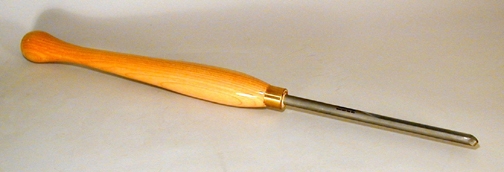
At the robust and sensible age of sixty-four, Bob Sweazey professes to be retired, but to the outside observer, it looks as if he traded one job for two active businesses. Besides his woodworking hobby, slanted somewhat toward turning these days, he runs a custom on-site wood milling business, and makes and sells the state-of-the-art bowl gouges that he designed and developed.
Sweazey’s first career was as a pilot. He started by flying helicopters in the Army, then spent 22 years as a pilot for a cargo company called Evergreen International Airlines. Along the way, he also taught in the aviation department of Oklahoma State University.
His interest in woodworking long predated his career, starting all the way back in grade school. By the time Bob was in first grade, he was already cobbling together his first woodworking project, a shoeshine box. Though his father, a machinist, had no connection to woodworking, Sweazey says that his early love of wood may have been pre-ordained. Both his grandfather and great-grandfather were carpenters, so perhaps it was in his blood. Nevertheless, he got into woodworking completely on his own, and kept the hobby his entire life.
“At first,” he explained, “the wood came from old orange and apple crates, and my first tools were a coping saw and a wood rasp.” His woodworking tools remained fairly primitive until after his marriage in 1965. “My first power tool was a Montgomery Ward radial arm saw. At the time, I thought you could do anything with it. I was right. You could do anything with it, but you couldn’t do anything right.” He blames the lack of rigidity at the end of the arm, which almost guarantees a corresponding lack of precision. I suppose that sentiment is not surprising with his machinist’s sensibilities and accuracy, no doubt inherited from his father.
That’s not to say he feels good tools are what make good craftsmen. “I’m an admitted tool freak,” he told me, “but I try to keep in mind the phrase ‘Good tools do not a craftsman make.’ In Hong Kong, I saw some workers who had a circular saw mounted on a piece of plywood on sawhorses, with two pieces of wood tacked down as a fence. Their finished work was as nice as you could imagine. It proved to me that you do not need expensive tools to do outstanding work.”
In spite of that, he both makes and owns some very nice tools, but he insists that they are good tools, as opposed to expensive tools. “There is a pleasure working with a quality tool,” he explains, “and it’s nice having just the right tool for the job. This probably comes from my salad days, when I often was frustrated at lacking the right tool.”
While in the Army, he had access to the military craft shops, and started building furniture. His object was to make all the furniture in his house. He says he came close, but the other commitments of life intruded.
“I bought a cheap, lightweight lathe in the mid seventies, and it resulted in total frustration. I put it aside and stopped turning.” Once he retired in 2000, his desire to turn was rekindled, but he was still frustrated with his lathe. Since he owned both a metal lathe and a milling machine, he decided he could, and should, build his own.
“I hired out the welding, but did all the machining myself. I designed the larger parts on a computer, and emailed the CAD files to the local steel supplier who cut, welded and powder-coated them. I copied Oneway’s tube-and-gusset bed design, but the rest is original.” His monster lathe boasts 60 inches between centers and a 27 inch swing, weighs 1,400 pounds, and is powered by a two horsepower, three-phase motor with infinite variable speed from 0 to 4,000 rpm, forward or reverse.
Having made a lathe like that, he felt he needed tools to match and, with help from turner Dave Schweitzer, designed the ultimate bowl gouge. “The Glazer gouge has been the best tool on the market. If that’s the best, what can I do to make it better?” he asked himself. “I consulted with metallurgists to select the best material, which is a premium M42 high speed cobalt steel.”
The handle is unusual as well. “My lathe is in an unheated area, where a metal handle is too uncomfortable, so I went with a wood handle. The handle was designed to reduce as much vibration as possible.” A half inch hole is drilled 12 inches in from the butt end, and the void is filled with number nine lead shot, then plugged. The shot not only helps balance the tool, it also provides heft and absorbs vibration. Bob cuts the metal shaft, turns the handles, and assembles the tools all by himself. He’s made and sold some 300 of the tools in less than a year.
His milling business was entirely accidental. It started when a neighbor’s oak tree fell. He built his own chain saw-powered mill to cut up the wood. Eventually, he replaced the mill in 1996 with a Wood-Mizer portable sawmill, which he takes to customers’ locations to mill logs. He replaced it with another in 2001 after the first was rear-ended by a truck while he was towing it back from a job site.
Between woodworking as a hobby, burgeoning gouge sales and the milling business, it is a wonder he has any retirement time to himself. “I tell my friends who are still working that if they have any major projects to do, get them done now,” Bob said, “because you sure as heck won’t have the time after you retire.”





